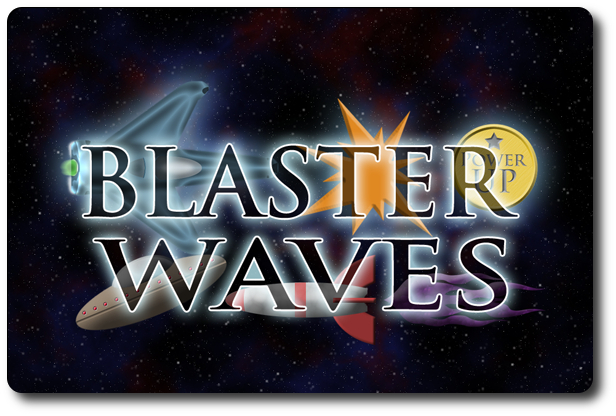
The Basics:
- For ages 8 and up (publisher suggests 10+)
- For 1 player
- Approximately 15 minutes to complete
Geek Skills:
- Counting & Math
- Logical & Critical Decision Making
- Reading
- Risk vs. Reward
- Hand/Resource Management
Learning Curve:
- Child – Easy
- Adult – Easy
Theme & Narrative:
- Get behind the stick of Earth’s most advanced and deadly space fighter!
Endorsements:
- Gamer Geek rejected!
- Parent Geek approved!
- Child Geek approved!
Overview
Congratulations, soldier. You’ve been hand selected to be the pilot of the most advanced space fighter humankind has ever constructed. But before the Government throws you the keys and pats you on the back, the “Powers That Be” want to see you in action. A training simulator has been programmed to test your skill, will, and grit. Survive it and we’ll know we picked the right pilot to defend Earth!
Blaster Waves, by Matt Worden Games, is comprised of 1 Player Ship card, 5 Boss Action cards, 48 Blaster Wave cards, 10 Health cards, 5 Level cards, and 17 Power Up cards. The cards in the game come in two sizes. The Player Ship, Boss Action, and Blaster Wave cards are the size of a traditional playing card. The Health, Level, and Power Up cards are referred to as “half-cards” and are roughly half the size of a traditional playing card. The game also comes with a small bag, if you purchase the game, that you can use to hold all the cards.
Game Set Up
To set up the game, first find and place the Player Ship card to the far left of the playing area. The Player Ship card looks like the space fighter from a top-looking-down perspective. The Player Ship card should be facing to the player’s right, as if the space fighter is flying from the left side of the playing area to the right side.
Second, directly above the Player Ship card, place 3 Health cards. The remaining Health cards should b placed in the upper left corner of the player’s playing area. Take a moment to review the Player Ship card. In addition to the Health location, a Power Up and Shields location is also present.
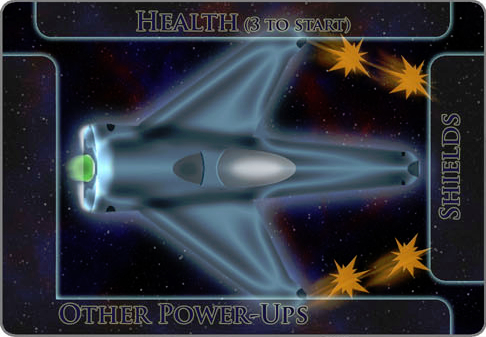
Third, sort the Level cards so that they are in sequential order. Level 1 should be on top, followed by Level 2 underneath, and so on. Place this stack of cards to the right of the Health cards.
Fourth, shuffle the Power Up cards and place them directly under the Health and Level cards.
Fifth, shuffle the Boss Action cards and play them, face-down (only “Boss Action” should be showing), in a line at the top of the playing area so they form a line of 5 cards from left to right.
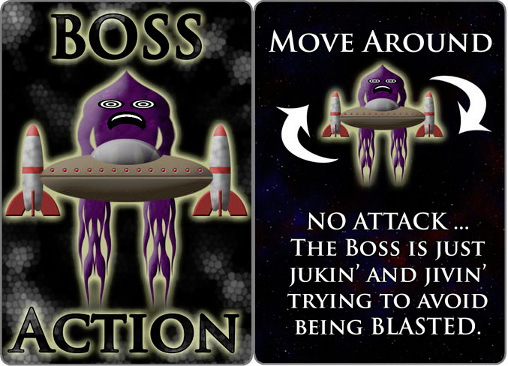
Sixth, shuffle the Blaster Wave cards and deal out 2, face-up, under each of the Boss Action cards so you have 5 columns of cards in total. Orientate the Blaster Wave cards so the “Alien Wave” information is at top. The “Alien Wave” portion of the card shows the alien ships, hit number, and a possible power up bonus.
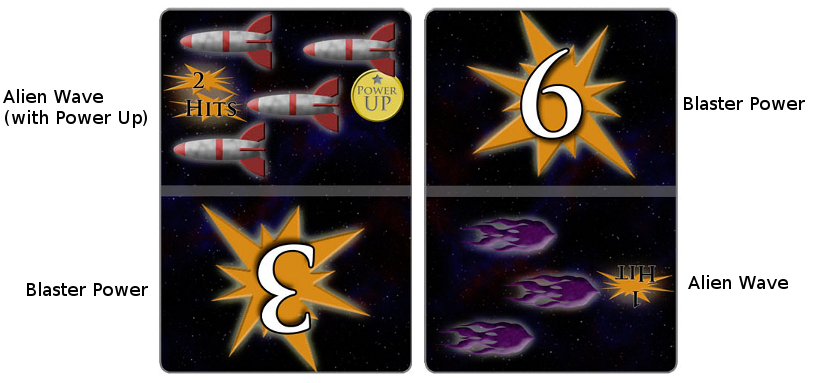
Seventh, deal three cards to the player. This is the player’s starting hand. The remaining Blaster Wave cards are kept face-down in their stack. This is now the draw deck. When you are done, your playing area will look similar to the following image.
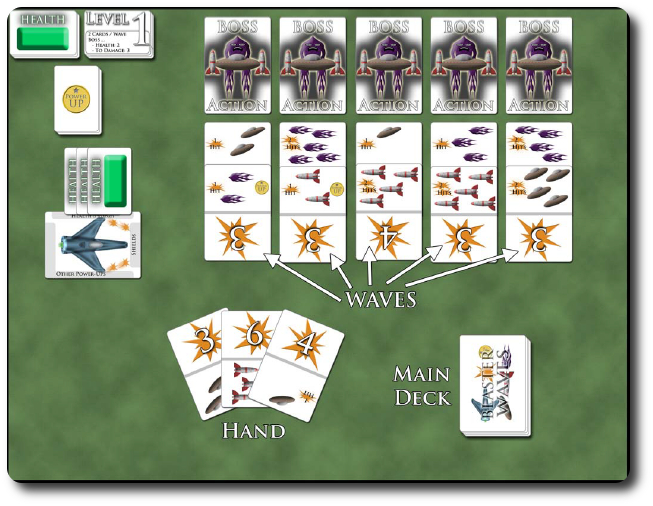
That’s it for set up! Time to launch and kick some alien butt!
Blasting Alien Scum
Blaster Waves is played in levels and does not conclude until the player completes all five levels or is vaporized. Each level is played using the following sequential steps.
Step 1: Level Set Up
The first thing a player should do is set up the level. This is done by shuffling and dealing the Boss Action cards in a row, face-down. The current Level card will list how many Blaster Wave cards go under each Boss Action card. The initial game set up creates the first level. For the second and remaining levels, the player will need to complete step 1 before continuing.
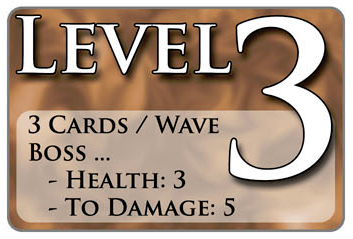
Step 2: Draw Cards
The player starts each level with 3 Blaster Wave cards. The player’s default hand size is 3 cards, however, the player can obtain Power Up cards that increase the hand size. Players should orientate the cards so that the Blaster value is at the top of the card, with the Alien Wave upside down and on the bottom.
Step 3: The Wave Round
A “Wave Round” is comprised of two sub-steps that repeat until all the Alien Waves have been removed from the playing area or the player’s ship is blown out of space. These sub-steps are summarized here.
- Sub-Step 1: Blast or Reload – The player can decide to either fire their weapon or reload. If they fire their weapon, they can play 1 or 2 Blaster Wave cards in their hand. If they play one card, a number of Alien Wave cards are removed, starting from the left most Boss Action column, until the total number of Alien Wave hit values is equal to (but not greater than) the card’s Blaster value. For example, if a player played a Blaster Wave card with a Blaster value of “4”, the player could remove 2 “1 Hit” Alien Wave cards and 1 “2 Hit” Alien Wave card (for a total of 4). If the player uses 2 Blaster Wave cards, only 1 Alien Wave card can be targeted (think of it as a “focused fire” action). If the player chooses to reload, they draw a number of Blaster Wave cards from the draw deck until their hand size is at its current maximum. HOWEVER, if the player reloads, all the cards in the left most column fire! The player takes a number of hits equal to all the Alien Wave “Hit values” who shot. For every 1 hit, the player looses 1 Health. If there are no alien ships in the left most column, the player’s ship is not fired upon.
- Sub-Step 2: Alien Wave Advances – The Alien Wave now shifts one column to the left. This is done for every column, starting with the left most column. Only one column space is shifted at a time, regardless if 2 or more might be free in front of the wave. A column cannot shift if the column it would enter is currently occupied by one or more alien ships.
Step 4: Big Boss Fight
Once all the Alien Waves have been neutralized, the Big Boss for that level appears and attempts to take out the player. What the Big Boss does is dependent on a Boss Action card. Starting with the left most Boss Action card, the player flips it over and completes the action noted on the card. This could be firing on the player (which can only be blocked if the player plays a card of equal value to the Big Boss’s attack), summon another Alien Wave, or just fly around. Before continuing, place a number of Health cards equal to the level’s stated Boss “Health” value under the right most Boss Action card.
Combat is just like before, except the new order is Boss Action first and then the player can decide if they want to use their blasters or reload them.
To attack the Big Boss, the player must play a number of Blaster Wave cards with a Blaster value equal to or higher than the Big Boss’s “To Damage” value. Each time the player does so, the Big Boss takes 1 damage to its Health. A Health card is removed from the right most Boss Action card to help keep track of how much Health the Big Boss has left. Once the player reduces the Big Boss’s Health to zero, the level is completed. The next Level card is now revealed going in sequential order, and a new Alien Wave appears as described in step 1 above.
All Blaster Wave cards that are played are “recycled” into the deck. This means the Blaster Wave deck is never reshuffled, but any played Blaster Wave cards are placed on the bottom of the deck. To a certain degree, the player can determine how their cards will be revealed later in the game.
POWER UP!
Each level exponentially increases in difficulty. As the game becomes more and more difficult to survive, it will quickly become apparent that no amount of luck or skill will keep a pilot alive for long without help. Lucky for the pilot (and the player), some of the aliens in the Alien Wave cards award the player Power Up cards. These Alien Wave cards have a Power Up coin on them. Once that particular alien is removed from the Alien Wave, the player draws 1 Power Up card. Some Power Up cards can be attached to the player’s ship and some give the player an instant boost, but are then recycled like the Blaster Wave cards.
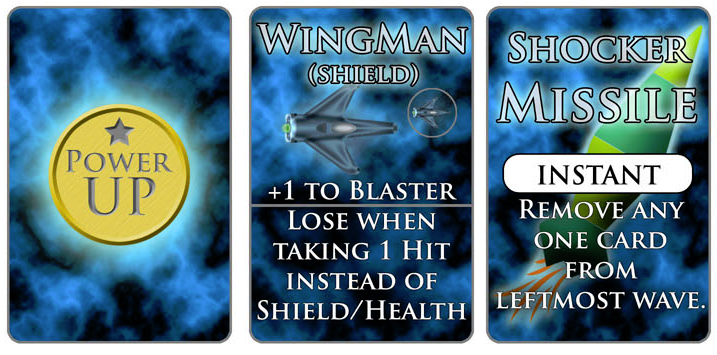
Endgame
The game ends one of two ways. The first, and most often, is when the player’s ship is reduced to floating space junk. When this happens, the player now tallies up their score. A player is awarded points for how many levels they completed, the round the player was destroyed on, and for any remaining Health on the ship, which in the case of being destroyed, would be zero. The total sum is calculated and then compared to a short list that ranks the player’s score.
The second way the game will end is the player completing all 5 Levels and defeating the Big Boss on Level 5. Points are tallied and then the player’s score is ranked.
To learn more about Blaster Waves, read the full rules, download a free print-n-play version of the game, and grab the Vassal module, visit the game’s official web page. The game is also available for purchase on The Game Crafter.
Prediction
Solitaire games tend to be of little interest in my household. We are a very social family and prefer to spend what free time we have in each others company. We’ll see if that changes when the little geeks turn into know-it-all teen geeks. To be honest, there is no solitaire game that my little geeks have not yet enjoyed because we play most of them together as a team. Working together to make decisions and sharing in the experience is one of the most well-kept secrets when it comes to solitaire game playing. Many people think that solitaire games are for one person, but this is far from the truth. Solitaire games are, in some respects, a true “cooperative” game when played with 2 or more people.
Blaster Waves sets up fast, plays fast, and puts a lot of control in the player’s hands. Creative freedom is reduced to “play now” or “play later”, however. But with lack of actions, the game reads very streamlined and keeps the complexity down. This should appeal to the Child Geeks and the Parent Geeks, especially the non-gamer types. I’m not yet convinced there is much in this game to tantalize the Gamer Geeks.
Teaching the game takes only a demo to get the most basic of concepts across. The game designer did a great job with the rule book and the first level is pretty much a cakewalk when it comes to difficulty. I taught the game by playing the first level while my little geeks observed. I then passed them the stick and reset the game to Level 1. No questions were asked and my 8 and 5-year-old understood exactly what needed to happen. But before I took the co-pilot seat and let them fly into the Alien Waves with blasters firing away, I asked them their thoughts on the game so far.
“Neat game! It reminds me of those old arcade games you showed me.” ~ Liam (age 8)
“I want to get a power up with really big lasers, Daddy!” ~ Nyhus (age 5)
Looks like all systems are go! Time to see if this game can fly on its own or crashes in a big fireball of disappointment.
Final Word
The Child Geeks had a great time playing this game. Note that my 8-year-old could play the game just fine, but my 5-year-old needed some help when it came to reading the cards. What we read to him made total sense in his mind, however, and he had no problem playing against whatever the game threw at him. And while my 8-year-old was a much stronger player, my 5-year-old was able to hold his own well into Level 3. Not too shabby! Based on the Child Geeks’ level of enthusiasm and easy game play that kept them challenged and engaged, Blaster Waves was approved by the Child Geeks.
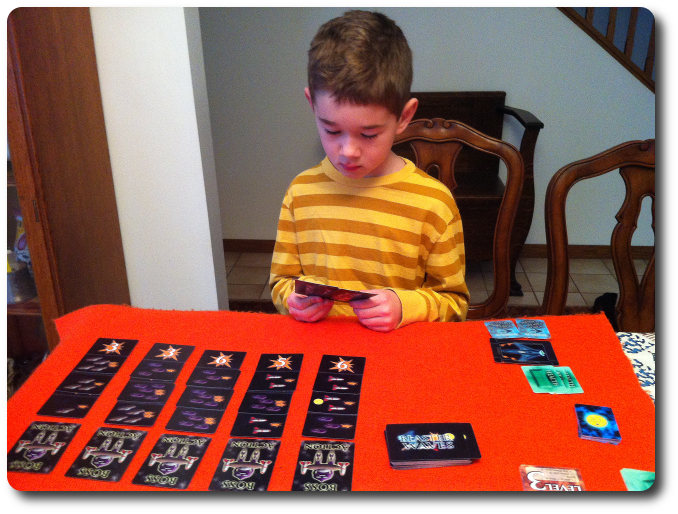
My little geek studies his cards as he considers his options and odds of survival
Parent Geeks also enjoyed the game and found it a lot of fun to play, not only with themselves, but even more so with their Child Geeks. The Parent Geeks really liked how simple math was used and forced the players to think hard about what cards they wanted to play. According to one Parent Geek, “this is a game that encourages critical thinking and strengthens math, while not feeling like a chore to do either!” Even the non-gamers enjoyed it, with one non-gamer Parent Geek saying, “this is better than Solitaire any day!” Based on the fun game play, the manageable level of difficulty, and worthwhile skills the game reinforced the Parent Geeks were most pleased to endorse this game.
The Gamer Geeks played the game and enjoyed it, but not to a point where they felt they could endorse it for three main reasons. The first was the level of ease in which the game was played and beaten. None of the Gamer Geeks we played the game with lost unless they didn’t have the right cards. Which brings us to the second reason why they didn’t endorse the game. The Gamer Geeks didn’t care for the fact that they were at the mercy of random card draws. While there was much card management that could be done once collected, the only thing saving a player from certain death was having cards big enough to wipe out the first 2 waves right away. If not, the player started taking damage quickly and eventually was vaporized. While the Power Ups were beneficial, they were sometimes too far and few between. Third, the Gamer Geeks didn’t think there was enough variety in the game play. Once you played the game through, the only thing you could expect to be different was what was included in the Alien Waves. This made the game something of a one-trick-pony, with little in the way of replay value. Basically, the Gamer Geeks really enjoyed the game until they beat it. Once they beat it, they never felt the need to revisit it again. The Gamer Geeks applauded the game for its original design and game play, but stopped just short of saying this was a “gamer’s game”.
I very much like this game, but like the Gamer Geeks, I don’t feel the need to play it again after beating it. In many ways, this is not a fault of the game, but more of an inherent characteristic of most solitaire games. Even with Blaster Waves offering a score breakdown that rates and ranks the player, I didn’t feel the need to play it again once I completed the 5th level. Until I did beat the game, I kept playing it over and over like a broken record. It consumed me and I was hellbent on beating it. While attempting to do so, my time with the game was very enjoyable and worthwhile. As such, I’m keeping the game and look forward to playing it again or offering it to my little geeks to play with me.
On a personal note, I think the game designer did a fantastic job of recreating the game play of the classic side-scrolling video games like Defender and R-Type. The steady increase in difficulty of each level, the power ups, and the Big Boss battles made me think of my younger years when I had much more time on my hands a burning desire to beat “Top Scores” at arcades in the strip mall. While those times in my life are long gone, the game brought back many pleasant memories.
If you are looking for a solitaire card game where the player is challenged to keep a cool head, a hot hand of cards, and a steady eye on the objective with an ever-increasing level of difficulty and always random wave of aliens, do set your targeting computer on Blaster Waves. It’s free to download and play or pay a bit and get it made for you. Either way, I think you’ll enjoy it at your gaming table.
This game was given to Father Geek as a review copy. Father Geek was not paid, bribed, wined, dined, or threatened in vain hopes of influencing this review. Such is the statuesque and legendary integrity of Father Geek.



